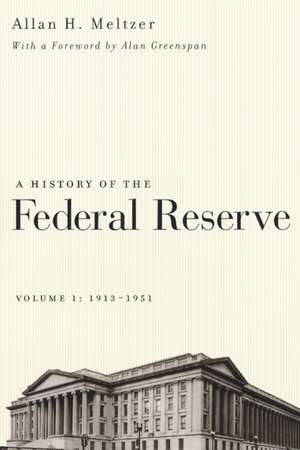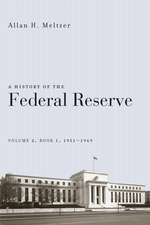A History of the Federal Reserve, Volume 1: 1913-1951
Autor Allan H. Meltzeren Limba Engleză Paperback – iun 2004
Allan H. Meltzer's monumental history of the Federal Reserve System tells the story of one of America's most influential but least understood public institutions. This first volume covers the period from the Federal Reserve's founding in 1913 through the Treasury-Federal Reserve Accord of 1951, which marked the beginning of a larger and greatly changed institution.
To understand why the Federal Reserve acted as it did at key points in its history, Meltzer draws on meeting minutes, correspondence, and other internal documents (many made public only during the 1970s) to trace the reasoning behind its policy decisions. He explains, for instance, why the Federal Reserve remained passive throughout most of the economic decline that led to the Great Depression, and how the Board's actions helped to produce the deep recession of 1937 and 1938. He also highlights the impact on the institution of individuals such as Benjamin Strong, governor of the Federal Reserve Bank of New York in the 1920s, who played a key role in the adoption of a more active monetary policy by the Federal Reserve. Meltzer also examines the influence the Federal Reserve has had on international affairs, from attempts to build a new international financial system in the 1920s to the Bretton Woods Agreement of 1944 that established the International Monetary Fund and the World Bank, and the failure of the London Economic Conference of 1933.
Written by one of the world's leading economists, this magisterial biography of the Federal Reserve and the people who helped shape it will interest economists, central bankers, historians, political scientists, policymakers, and anyone seeking a deep understanding of the institution that controls America's purse strings.
"It was 'an unprecedented orgy of extravagance, a mania for speculation, overextended business in nearly all lines and in every section of the country.' An Alan Greenspan rumination about the irrational exuberance of the late 1990s? Try the 1920 annual report of the board of governors of the Federal Reserve. . . . To understand why the Fed acted as it did—at these critical moments and many others—would require years of study, poring over letters, the minutes of meetings and internal Fed documents. Such a task would naturally deter most scholars of economic history but not, thank goodness, Allan Meltzer."—Wall Street Journal
"A seminal work that anyone interested in the inner workings of the U. S. central bank should read. A work that scholars will mine for years to come."—John M. Berry, Washington Post
"An exceptionally clear story about why, as the ideas that actually informed policy evolved, things sometimes went well and sometimes went badly. . . . One can only hope that we do not have to wait too long for the second installment."—David Laidler, Journal of Economic Literature
"A thorough narrative history of a high order. Meltzer's analysis is persuasive and acute. His work will stand for a generation as the benchmark history of the world's most powerful economic institution. It is an impressive, even awe-inspiring achievement."—Sir Howard Davies, Times Higher Education Supplement
To understand why the Federal Reserve acted as it did at key points in its history, Meltzer draws on meeting minutes, correspondence, and other internal documents (many made public only during the 1970s) to trace the reasoning behind its policy decisions. He explains, for instance, why the Federal Reserve remained passive throughout most of the economic decline that led to the Great Depression, and how the Board's actions helped to produce the deep recession of 1937 and 1938. He also highlights the impact on the institution of individuals such as Benjamin Strong, governor of the Federal Reserve Bank of New York in the 1920s, who played a key role in the adoption of a more active monetary policy by the Federal Reserve. Meltzer also examines the influence the Federal Reserve has had on international affairs, from attempts to build a new international financial system in the 1920s to the Bretton Woods Agreement of 1944 that established the International Monetary Fund and the World Bank, and the failure of the London Economic Conference of 1933.
Written by one of the world's leading economists, this magisterial biography of the Federal Reserve and the people who helped shape it will interest economists, central bankers, historians, political scientists, policymakers, and anyone seeking a deep understanding of the institution that controls America's purse strings.
"It was 'an unprecedented orgy of extravagance, a mania for speculation, overextended business in nearly all lines and in every section of the country.' An Alan Greenspan rumination about the irrational exuberance of the late 1990s? Try the 1920 annual report of the board of governors of the Federal Reserve. . . . To understand why the Fed acted as it did—at these critical moments and many others—would require years of study, poring over letters, the minutes of meetings and internal Fed documents. Such a task would naturally deter most scholars of economic history but not, thank goodness, Allan Meltzer."—Wall Street Journal
"A seminal work that anyone interested in the inner workings of the U. S. central bank should read. A work that scholars will mine for years to come."—John M. Berry, Washington Post
"An exceptionally clear story about why, as the ideas that actually informed policy evolved, things sometimes went well and sometimes went badly. . . . One can only hope that we do not have to wait too long for the second installment."—David Laidler, Journal of Economic Literature
"A thorough narrative history of a high order. Meltzer's analysis is persuasive and acute. His work will stand for a generation as the benchmark history of the world's most powerful economic institution. It is an impressive, even awe-inspiring achievement."—Sir Howard Davies, Times Higher Education Supplement
Preț: 237.48 lei
Nou
Puncte Express: 356
Preț estimativ în valută:
45.45€ • 47.18$ • 37.90£
45.45€ • 47.18$ • 37.90£
Carte disponibilă
Livrare economică 03-17 martie
Livrare express 14-20 februarie pentru 51.51 lei
Preluare comenzi: 021 569.72.76
Specificații
ISBN-13: 9780226520001
ISBN-10: 0226520005
Pagini: 808
Ilustrații: 47 line drawings, 76 tables
Dimensiuni: 152 x 229 x 56 mm
Greutate: 1.08 kg
Ediția:1
Editura: University of Chicago Press
Colecția University of Chicago Press
ISBN-10: 0226520005
Pagini: 808
Ilustrații: 47 line drawings, 76 tables
Dimensiuni: 152 x 229 x 56 mm
Greutate: 1.08 kg
Ediția:1
Editura: University of Chicago Press
Colecția University of Chicago Press
Notă biografică
Allan H. Meltzer is the Allan H. Meltzer University Professor of Political Economy at Carnegie Mellon University and Visiting Scholar at the American Enterprise Institute, Washington, D.C.
Cuprins
Foreword, Alan Greenspan
Preface
1. Introduction
2. Central Banking Theory and Practice before the Federal Reserve Act
3. In the Beginning, 1914 to 1922
4. New Procedures, New Problems, 1923 to 1929
5. Why Did Monetary Policy Fail in the Thirties?
6. In the Backseat, 1933 to 1941
7. Under Treasury Control, 1942 to 1951
8. Conclusion: The First Thirty-seven Years
References
Data Sources
Index
Preface
1. Introduction
2. Central Banking Theory and Practice before the Federal Reserve Act
3. In the Beginning, 1914 to 1922
4. New Procedures, New Problems, 1923 to 1929
5. Why Did Monetary Policy Fail in the Thirties?
6. In the Backseat, 1933 to 1941
7. Under Treasury Control, 1942 to 1951
8. Conclusion: The First Thirty-seven Years
References
Data Sources
Index
Recenzii
“A History of the Federal Reserve will be the definitive history of the central bank and monetary policy in the United States for the indefinite future. Every student of the American economy during the period of this account will find something of interest here, and anyone seeking to fathom the ‘big picture’ of economic policy during these years will be greatly enlightened by reading this extraordinary work of scholarship.”













